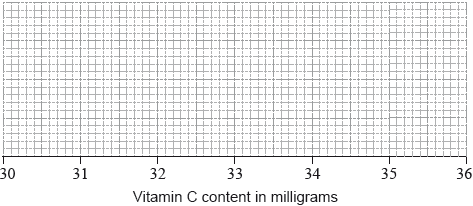| Date | May 2022 | Marks available | 2 | Reference code | 22M.2.AHL.TZ1.3 |
| Level | Additional Higher Level | Paper | Paper 2 | Time zone | Time zone 1 |
| Command term | Find | Question number | 3 | Adapted from | N/A |
Question
A Principal would like to compare the students in his school with a national standard. He decides to give a test to eight students made up of four boys and four girls. One of the teachers offers to find the volunteers from his class.
The marks out of , for the students who took the test, are:
For the eight students find
The national standard mark is out of .
Two additional students take the test at a later date and the mean mark for all ten students is and the standard deviation is .
For further analysis, a standardized score out of for the ten students is obtained by multiplying the scores by and adding .
For the ten students, find
Name the type of sampling that best describes the method used by the Principal.
the mean mark.
the standard deviation of the marks.
Perform an appropriate test at the significance level to see if the mean marks achieved by the students in the school are higher than the national standard. It can be assumed that the marks come from a normal population.
State one reason why the test might not be valid.
their mean standardized score.
the standard deviation of their standardized score.
Markscheme
quota A1
[1 mark]
(M1)A1
[2 marks]
A1
[1 mark]
(let be the national mean)
A1
Note: Accept hypotheses in words if they are clearly expressed and ‘population mean’ or ‘school mean’ is referred to. Do not accept unless is explicitly defined as “national standard mark” or given as .
recognizing -test (M1)
-value A1
R1
Note: The R1 mark is for the comparison of their -value with .
insufficient evidence to reject the null hypothesis (that the mean for the school is ) A1
Note: Award the final A1 only if the null hypothesis is also correct (e.g. or (population) mean ) and the conclusion is consistent with both the direction of the inequality and the alternative hypothesis.
[5 marks]
EITHER
the sampling process is not random R1
For example:
the school asked for volunteers
the students were selected from a single class
OR
the quota might not be representative of the student population R1
For example:
the school may have only boys and girls.
Note: Do not accept ‘the sample is too small’.
[1 mark]
A1
[1 mark]
(A1)
A1
[2 marks]
Examiners report
The most common answer to this question was ‘convenience sampling’. Though it is a convenience sample because four boys and four girls were required the most appropriate response was ‘quota sampling’.
Some candidates still try to calculate a mean and standard deviation by hand. This is not expected.
This was surprisingly poorly answered given that statistical testing forms a large part of the course. Candidates need to give the null and alternative hypotheses, find a p-value, compare this to the significance level and write their conclusion, in context of the question; examination questions may ask for each element individually or the question may say “Perform the test” wherein it is expected that each individual element will be clearly stated (as the test is incomplete if any are omitted). Many candidates had the null hypothesis as an inequality. The easiest way to write the null hypothesis is , but it could also be stated in words so long as it is clear that the population mean is being referred to rather than the sample mean. For example, H0: The mean score of the whole school is equal to 25.2.
The answer that the sample was self-selecting or unrepresentative was the expected response. The sample being small was also accepted if the additional reason of therefore ‘not able to assume a normal population’ was also given. In general, a small sample can be valid (though will probably not be reliable).
Some candidates missed the point of this question, that it was concerned with transformations of the mean and standard deviation, and instead tried to work out the actual values for the extra two candidates.



